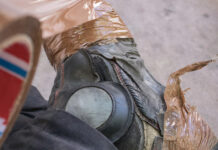Glove ratings can be a useful piece of information when it comes to selecting the right gloves for you. However, the key is to pay attention to the right glove rating when choosing a glove that is right for your specific job. There are several tests for work gloves that determine the ratings, but which rating is the most important for your task, the test for cut, punctures, abrasion or dexterity? Reviewing the test standards for safety gloves can give you a crash course in selecting the perfect glove for your workplace.
For cut, the test is simple. ANSI uses a sharp metal blade that moves across the glove material until it cuts through. The ratings for cut range from 0 to 5, 0 for less than 200 grams and 5 for over 3500 grams.
Choosing the right puncture test can be a little more complicated. Puncture tests make use of very different sized probes, a large nail, a small nail and a hypodermic needle. To choose which test best applies to you, you must consider your specific safety requirement.
For abrasion, ANSI uses the Taber test. The Taber test counts the number of cycles it takes an abrasive surface to wear through the glove material. The ratings range from levels 0 to 6, 6 being the highest. Level 6 material makes it through over 20,000 revolutions of wear while level 1 material only needs to make it through 100 cycles.
There are three standardized tests available for dexterity. The first is the pin test, requiring a person to wear the glove and pick up five pins of different sizes. The glove that allows the wearer to pick up the smallest pin gets the highest rating. The second dexterity test is the Minnesota Manual Dexterity Test which requires the glove-wearer to place 60 individual disks in a series of test patterns, once while wearing the gloves and once while not wearing the gloves. The test compares the two results to determine the dexterity rating. The circular bend test is the third test. The palm section of the glove is used as a sample and is placed over a 1-inch opening on a compression-testing machine. The machine consists of a plunger that gets pushed through the glove sample. The less force it takes to press the glove material through the opening, the higher the dexterity rating.
After reviewing the testing procedures for cut resistant gloves and the best dexterity for gloves, hopefully you can determine which ratings are the most valuable to you. You must first consider your workplace safety hazards and then chose a safety glove accordingly. For a wide selection of safety gloves appropriate for various work activities, check out Working Person’s Store!




